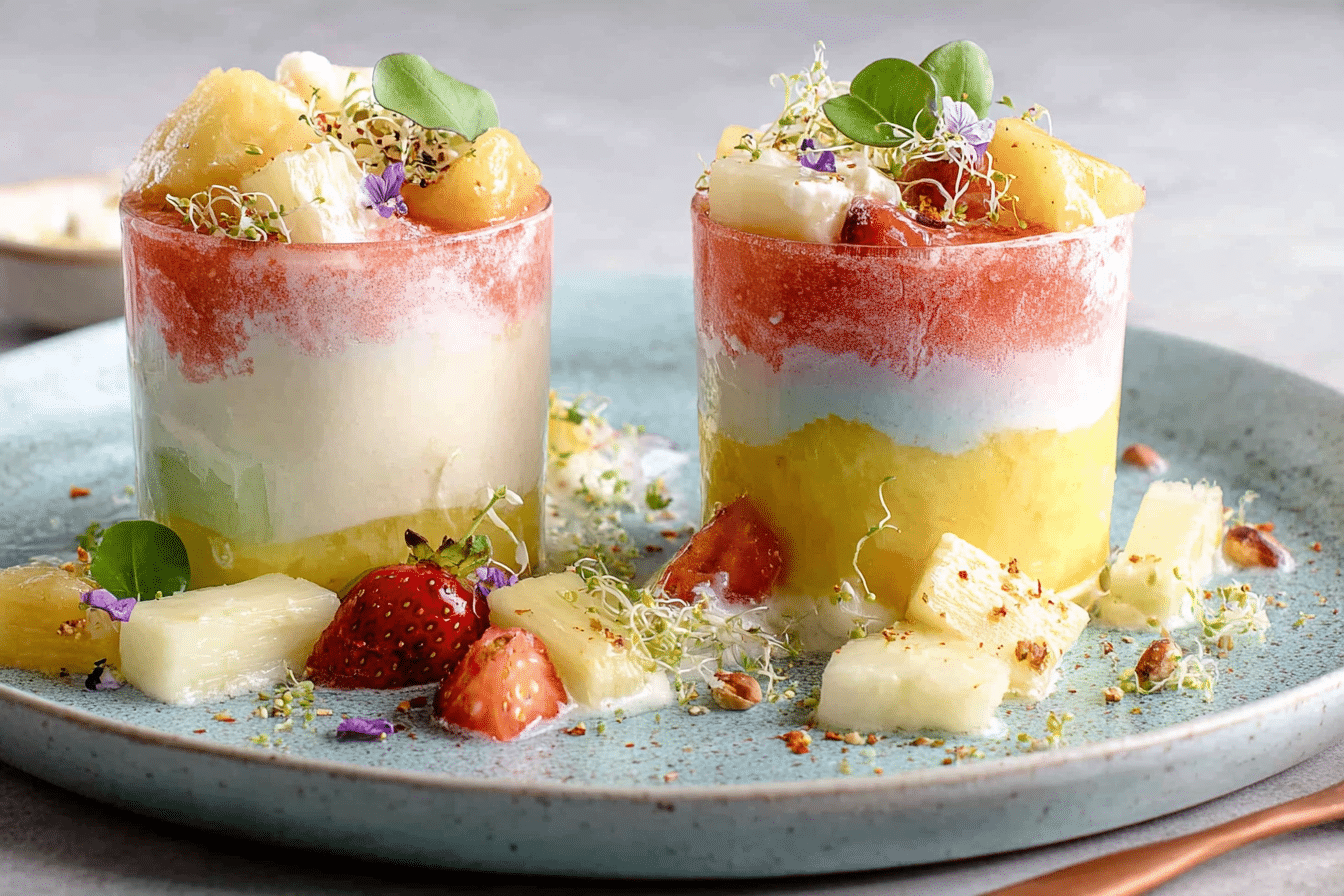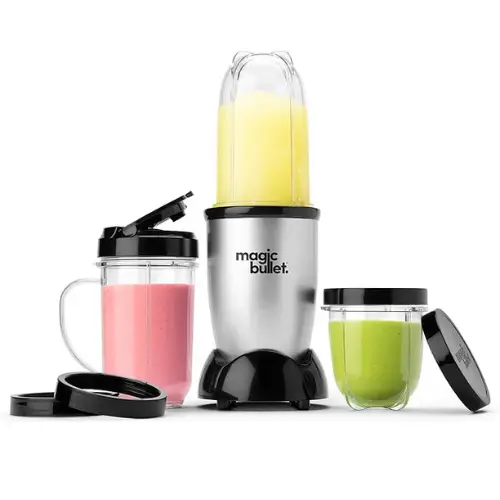Anti-Inflammatory Pineapple Smoothie is more than just a colorful blend of tropical fruit—it’s a game-changer for anyone seeking natural relief from chronic inflammation. Loaded with fresh pineapple, pears, lemon juice, and a subtle punch of celery seeds, this smoothie is a therapeutic beverage that’s as delicious as it is effective.
Disclosure: This post contains affiliate links.If you click and make a purchase, I may earn a small commission at no extra cost to you.
I created this Anti-Inflammatory Pineapple Smoothie recipe while struggling with persistent joint pain and digestive discomfort during my wellness journey. After experimenting with different anti-inflammatory foods, I found this blend calmed my gut, improved my energy, and brought back my morning glow.
That’s when I decided to share it on my About page and make it part of my daily ritual. My readers have echoed similar results, and it’s become one of the most loved recipes in our health community. Looking for inspiration? Try this pineapple fluff twist for a sweeter variation.
In this comprehensive guide, you’ll discover not only how to make this smoothie but also how each ingredient supports your body’s natural healing. We’ll explore anti-inflammatory science, flavor variations, expert tips, and practical hacks to make this smoothie part of your daily wellness practice.
Table of Contents
Table of Contents
What is an Anti-Inflammatory Pineapple Smoothie?
An anti-inflammatory pineapple smoothie is a nutrient-rich blend designed to help combat inflammation in the body using powerful natural ingredients. Pineapple, the star of this smoothie, is packed with bromelain, a digestive enzyme shown to reduce swelling and promote tissue healing. When paired with pears (fiber-rich), lemon juice (alkalizing), and celery seeds (anti-inflammatory properties), you get a synergistic, inflammation-fighting elixir.
This smoothie isn’t just for pain relief—it’s your all-in-one solution for gut health, glowing skin, and mental clarity. It’s dairy-free, gluten-free, and loaded with antioxidants, making it a smart choice for almost any dietary plan, including vegan, paleo, and Whole30.
Why Pineapple is a Powerful Anti-Inflammatory Fruit
Pineapple is no ordinary tropical fruit. Its main claim to fame is bromelain, a natural enzyme that fights inflammation at the cellular level. Studies show bromelain may be as effective as some over-the-counter anti-inflammatory drugs—but without the side effects.
In addition to bromelain, pineapple provides:
- Vitamin C: Boosts immune function
- Manganese: Supports joint and bone health
- Flavonoids: Combat oxidative stress
- Fiber: Supports digestion and satiety
Adding frozen pineapple to smoothies creates a thick, frosty texture while delivering intense flavor and nutrients. Plus, it’s readily available year-round, making it a convenient superfruit for daily use. Don’t miss our healthy energy ball recipe for another anti-inflammatory snack option.
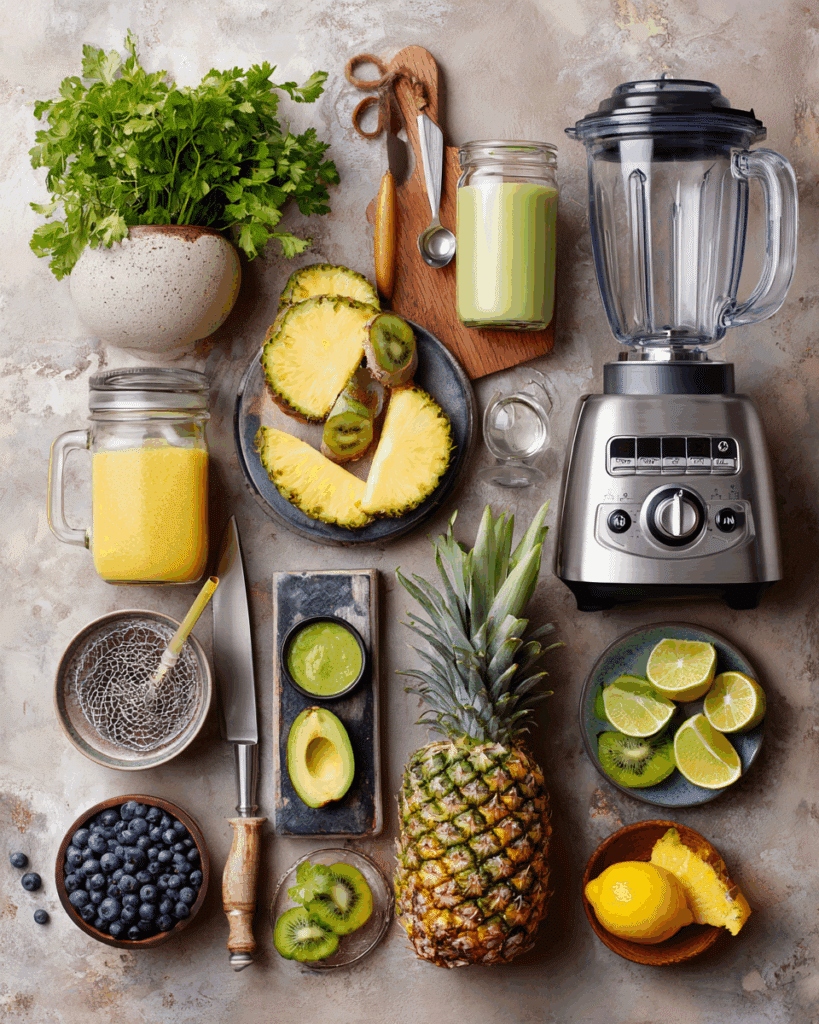
About Page Story: How This Smoothie Became My Go-To Wellness Ritual
The inspiration behind this smoothie came during a tough health chapter. I had just transitioned to a plant-forward diet to address recurring inflammation flare-ups, and I was desperate for something refreshing, energizing, and healing. After weeks of trial and error, I stumbled upon the power combo of pineapple and celery seed in a detox guide and began crafting this smoothie every morning.
Not only did my joint stiffness ease within weeks, but I also noticed a sharper mind and more vibrant skin. That’s when I shared the recipe in my “About” page, and since then, it’s been embraced by thousands looking for a natural solution to inflammation.
Print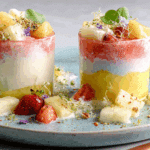
Anti-Inflammatory Pineapple Smoothie A Sweet and Powerful Anti-Bloat Drink
- Prep Time: 5 minutes
- Cook Time: 0 minutes (no‑cook)
- Total Time: 5 minutes
- Yield: 2 servings
- Category: Smoothie
- Method: Blending
- Cuisine: American
- Diet: Vegan
Description
A refreshing, no‑cook anti‑inflammatory smoothie combining frozen pineapple and ripe pears with creamy coconut milk, bright lemon juice, and optional celery seeds—loaded with bromelain and antioxidants.
Ingredients
- 3 cups frozen pineapple
- 2 soft ripe pears, chopped
- 1 1/4 cups coconut milk (or any dairy‑free milk)
- 1 Tbsp fresh lemon juice
- 1/2 tsp celery seeds (optional)
- Optional color layers: 1/2 cup raspberries for pink layer; pinch turmeric powder for yellow layer;
- For topping (optional): coconut yogurt, shredded coconut
Instructions
- Combine frozen pineapple, chopped pears, coconut milk, lemon juice, and celery seeds in a blender; blend until smooth and creamy; add more milk if needed for desired consistency. :contentReference[oaicite:0]{index=0}
- For layered presentation: separate about ½ cup for a pink layer and blend with raspberries; mix a pinch of turmeric into another ¼ cup for a yellow layer. :contentReference[oaicite:1]{index=1}
- Layer smoothie carefully by pouring layers one at a time using the back of a spoon for clean lines; top with coconut yogurt and shredded coconut if desired. :contentReference[oaicite:2]{index=2}
- Serve immediately for maximum freshness and anti‑inflammatory benefit. :contentReference[oaicite:3]{index=3}
Notes
- Use only soft, ripe pears—unripe pears can introduce bitterness. :contentReference[oaicite:4]{index=4}
- Frozen pineapple keeps texture thick and frosty without ice. :contentReference[oaicite:5]{index=5}
- Celery seeds and lemon juice boost anti‑inflammatory properties and flavor. :contentReference[oaicite:6]{index=6}
- Customize with banana, green grapes (in place of pears), or add protein/greens like spinach. :contentReference[oaicite:7]{index=7}
- Store any leftover smoothie in a covered container in the fridge up to 24 hrs; give a quick blend or shake before serving. :contentReference[oaicite:8]{index=8}
Nutrition
- Serving Size: 1 serving
- Calories: ≈180 kcal
Health Benefits of the Anti-Inflammatory Pineapple Smoothie
Key Anti-Inflammatory Ingredients Explained
What makes this anti-inflammatory pineapple smoothie such a nutritional powerhouse? It’s the strategic blend of ingredients—each one handpicked not just for flavor, but for its proven ability to calm inflammation and support overall wellness. Let’s break it down:
- Pineapple (3 cups, frozen): Beyond its juicy sweetness, pineapple delivers bromelain, an enzyme studied for reducing inflammation, easing sinus congestion, and aiding post-surgery recovery. It’s a natural pain reliever without the side effects.
- Fresh pears (2 soft pears, cored and peeled or not): These fiber-rich fruits promote gut health and balance blood sugar—two important factors in controlling chronic inflammation. Pears also contain quercetin, a plant compound linked to reduced histamine responses.
- Lemon juice (1 tablespoon): A potent alkalizer, lemon juice helps flush toxins from the body. Its high vitamin C content strengthens immunity and neutralizes oxidative stress.
- Celery seeds (½ to 1 teaspoon): These underrated spices are bursting with apigenin and luteolin—natural plant chemicals that have been shown to lower inflammation markers in the body.
- Dairy-free milk (1 ¼ cup, any variety): Almond, oat, or coconut milk keeps this smoothie dairy-free, gut-friendly, and light. Dairy often contributes to inflammation, so choosing an alternative helps reduce reactivity.
Looking for inspiration? Try combining this with our coconut curry chicken soup on chillier days for a full anti-inflammatory combo.
Together, these ingredients don’t just taste good—they work in harmony to:
- Decrease joint pain
- Improve digestion
- Support immune function
- Reduce oxidative stress
- Boost hydration and energy
How These Nutrients Work Together to Reduce Inflammation
The anti-inflammatory pineapple smoothie isn’t just a collection of superfoods—it’s a strategic formula. Here’s how the magic happens:
- Synergistic Action: When bromelain (from pineapple) and quercetin (from pears) team up, their anti-inflammatory effect becomes more powerful. Studies show that combining these two compounds increases bioavailability and supports tissue repair.
- Gut-Brain Axis Support: Pears and lemon juice provide fiber and prebiotics that nourish your gut microbiome. A healthy gut means fewer inflammation signals sent to your brain and joints.
- Alkalizing + Detox: Celery seeds and lemon juice create an alkaline environment in the body, helping reduce acidic buildup which often contributes to chronic inflammation.
- Antioxidant Armor: Each ingredient is rich in antioxidants—flavonoids, vitamin C, and polyphenols—that defend against free radicals, the main culprits behind aging and inflammation.
- Cooling Properties: Unlike caffeine or processed snacks that overstimulate your system, this smoothie cools internal heat. That’s essential for calming inflammatory conditions like arthritis, IBS, or eczema.
Anti-Inflammatory Pineapple Smoothie Ingredients Breakdown
Detailed Nutritional Profile of Each Ingredient
This anti-inflammatory pineapple smoothie stands out because of how each ingredient delivers a specific set of nutrients that support the body’s natural healing processes. Let’s dig deeper into what’s really in your glass.
Pineapple (3 cups, frozen)
- Bromelain: A powerful enzyme known for reducing swelling, aiding digestion, and helping with joint recovery.
- Vitamin C: One serving contains over 100% of your daily value, which boosts immunity and fights inflammation.
- Manganese: Supports connective tissue strength and metabolic health.
- Natural sugars: Provide clean energy without a blood sugar crash thanks to fiber content.
Pears (2 fresh soft pears)
- Quercetin: A plant flavonoid that helps stabilize cells and suppress histamine, easing inflammation.
- Soluble fiber (pectin): Promotes a healthy gut lining and regulates blood sugar levels.
-
Copper + Vitamin K: Support bone health and metabolic function.
Tip: Don’t peel the pears if you want the full fiber benefit—just wash them well.
Lemon Juice (1 tablespoon)
- Ascorbic acid: This form of vitamin C neutralizes free radicals and boosts skin repair.
- Citric acid: Helps the liver detox and maintains pH balance.
- Flavonoids: Support capillary strength and reduce oxidative stress.
Celery Seeds (½ to 1 teaspoon)
- Apigenin + Luteolin: Natural antioxidants that suppress the production of inflammatory cytokines.
- Minerals: Packed with calcium, magnesium, and iron, which aid in regulating nerve and muscle function.
- Diuretic properties: Help flush excess water and toxins, reducing bloating and puffiness.
Dairy-Free Milk (1¼ cup)
Choose your favorite:
- Almond milk: Rich in vitamin E and light in texture.
- Oat milk: Naturally sweet and high in beta-glucans that support heart and gut health.
-
Coconut milk: Contains lauric acid, which has antimicrobial and anti-inflammatory effects.
These plant-based options are free of lactose and casein—two dairy components that may trigger inflammation in sensitive individuals.
Pro Tip: Want to boost anti-inflammatory benefits even more? Add a scoop of plant-based collagen or hemp seeds for extra omega-3s.
Discover great ideas like this fruity frappuccino treat that pair well with your smoothie for a complete morning reset.
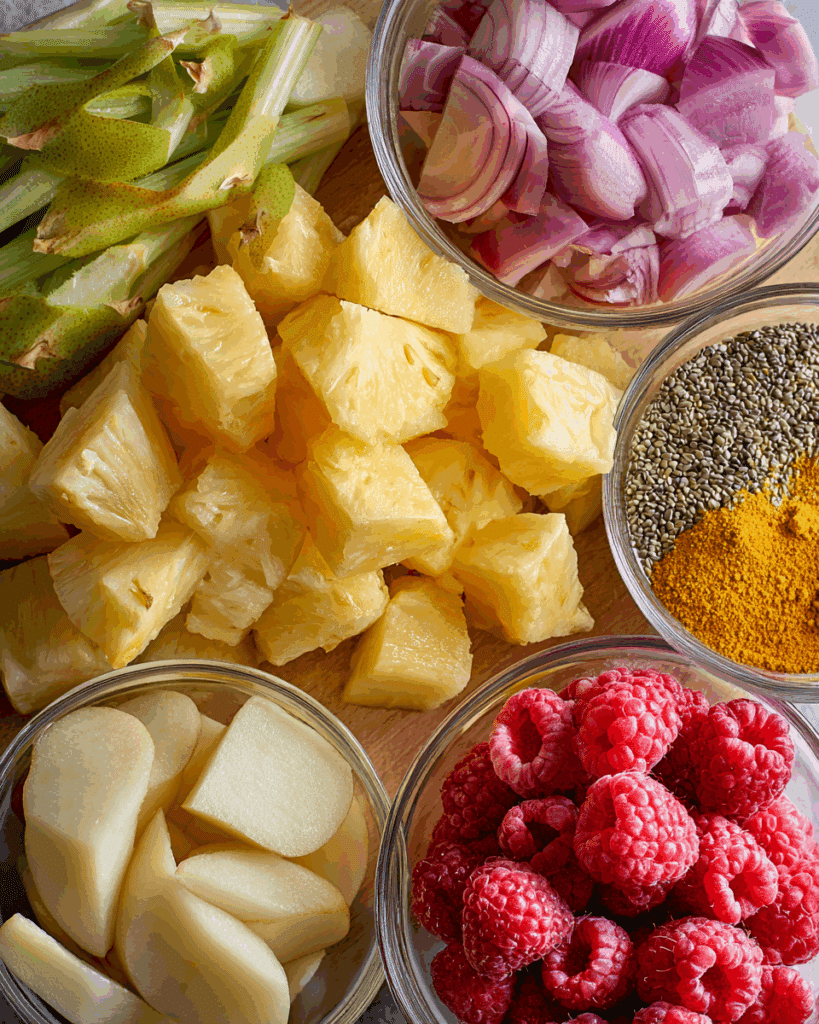
The Role of Pineapple, Pears, Celery Seeds & Lemon Juice
Together, these ingredients create a synergistic blend that goes beyond the sum of its parts:
- Pineapple breaks down proteins and calms swelling, especially useful for post-workout recovery or sore joints.
- Pears introduce gut-healing fiber and flavonoids that soothe the digestive tract and reduce skin flare-ups.
- Lemon juice enhances detox and helps mobilize waste, while giving the smoothie a bright, refreshing finish.
- Celery seeds serve as a natural anti-inflammatory booster, regulating blood pressure and reducing histamine overproduction.
All of this wrapped in a smooth, creamy texture, thanks to the dairy-free milk that ties the drink together without disrupting your body’s healing process.
How to Make the Perfect Anti-Inflammatory Pineapple Smoothie
Step-by-Step Blending Instructions
Creating the perfect anti-inflammatory pineapple smoothie at home is refreshingly simple. But doing it right means getting the texture, flavor, and nutrient integrity just right. Here’s your complete guide.
Basic Pineapple Smoothie Recipe
Ingredients:
- 3 cups frozen pineapple
- 1¼ cup dairy-free milk (almond, oat, or coconut)
- 2 soft pears (peeled or unpeeled, cored)
- 1 tablespoon lemon juice
- ½ to 1 teaspoon celery seeds
Instructions:
- Start with the liquids: Pour the dairy-free milk into the blender first. This helps keep the blades moving smoothly.
- Add frozen pineapple and pears: Layer in the pineapple and chopped pears. Frozen fruit gives it a thick, frosty consistency.
- Toss in celery seeds: These add a mild, earthy flavor and anti-inflammatory kick. Start with ½ tsp and increase based on taste.
- Squeeze in lemon juice: Brightens flavor and enhances absorption of antioxidants.
- Blend until smooth: Process on high for 30–45 seconds until silky and uniform. Add more milk if it’s too thick.
Optional: For added protein, toss in chia seeds, flaxseed meal, or a scoop of your favorite plant-based protein powder.
This base recipe creates the perfect consistency for sipping or turning into a smoothie bowl. For a crunch, top it with granola or shredded coconut.
Check out how to elevate simple ingredients like in this energy-boosting cracker toffee to pair with your smoothie.
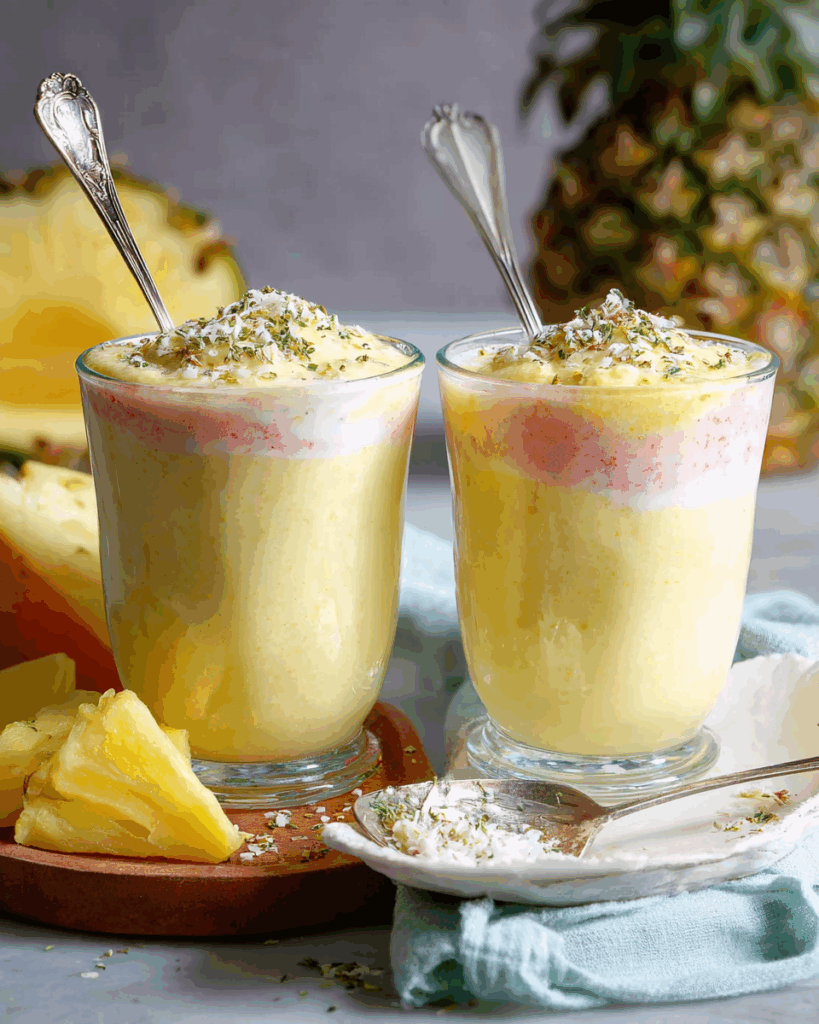
Tips for Getting the Ideal Texture and Flavor Balance
Getting your pineapple smoothie just right is about more than just throwing ingredients in a blender. Here’s how to ensure every sip is satisfying:
| Issue | Fix |
|---|---|
| Too watery? | Add more frozen pineapple or a few ice cubes. |
| Too thick? | Blend in a splash more milk or a tablespoon of lemon water. |
| Too tart? | Add half a ripe banana or 1 tsp of maple syrup. |
| Too earthy? | Reduce celery seeds slightly or balance with more lemon. |
Additional flavor upgrades:
- Spice it up: Add a slice of fresh ginger for extra anti-inflammatory power.
- Make it creamy: Blend in 1 tablespoon of coconut yogurt or soaked cashews.
- Sweeten it naturally: Medjool dates or honey (if not strictly vegan) add smooth sweetness.
Don’t miss our banana pudding delight for another creamy treat with anti-inflammatory flair.
Once you master the texture and balance, this smoothie becomes the one drink you look forward to all day—perfect for post-gym recovery, breakfast on the go, or an afternoon pick-me-up.
Variations of the Pineapple Smoothie for Anti-Inflammatory Benefits
Pink Pineapple Smoothie: With Raspberries
One of the best things about the Anti-Inflammatory Pineapple Smoothie is how versatile it is. Want to change the color, flavor, or antioxidant profile without compromising on inflammation-fighting power? Let’s start with the pink version.
Why Add Raspberries?
Raspberries aren’t just pretty—they’re packed with anthocyanins, vitamin C, and ellagic acid. These natural compounds reduce oxidative stress and support detoxification. When blended into your Anti-Inflammatory Pineapple Smoothie, they add a subtle tang and a vibrant hue.
Pink Smoothie Instructions:
- Follow the base Anti-Inflammatory Pineapple Smoothie recipe.
- Scoop out ½ cup of the finished smoothie.
- Add ¼ cup fresh or frozen raspberries and blend again until fully pink.
- Spoon it over the original smoothie to create a beautiful, layered look.
You can muddle raspberries directly into the smoothie as well for a rustic texture, or use a strainer if you want a smoother result.
Want to pair it with something festive? Don’t miss our fruit-filled cherry dessert pizza for a naturally sweet finish.
This version of the Anti-Inflammatory Pineapple Smoothie adds extra polyphenols, fiber, and a subtle berry brightness that complements the pineapple without overpowering it. Plus, it’s visually stunning—Instagram-worthy and deeply nutritious.
Bright Yellow Pineapple Smoothie: With Turmeric
Ready to glow from the inside out? Enter the Bright Yellow Anti-Inflammatory Pineapple Smoothie, supercharged with turmeric. This variation turns up the healing volume with curcumin, the golden spice known for its anti-inflammatory superpowers.
Why Add Turmeric?
Turmeric has been used for centuries to ease inflammation, reduce joint pain, and improve skin clarity. Its active compound, curcumin, works synergistically with bromelain in pineapple, creating a one-two punch against chronic inflammation.
Yellow Smoothie Instructions:
- Take ¼ cup of the original Anti-Inflammatory Pineapple Smoothie.
- Stir in a pinch of turmeric powder (about ⅛ tsp).
- Mix until fully dissolved.
You can layer this golden mix atop the base smoothie, or serve it between the original and pink layers for a tropical sunrise effect.
Fun tip: Add a crack of black pepper to boost turmeric absorption (just a little goes a long way).
For an even more tropical finish, top your Anti-Inflammatory Pineapple Smoothie with a dollop of coconut yogurt and a sprinkle of shredded coconut. The creaminess balances the bright notes of turmeric and lemon perfectly.
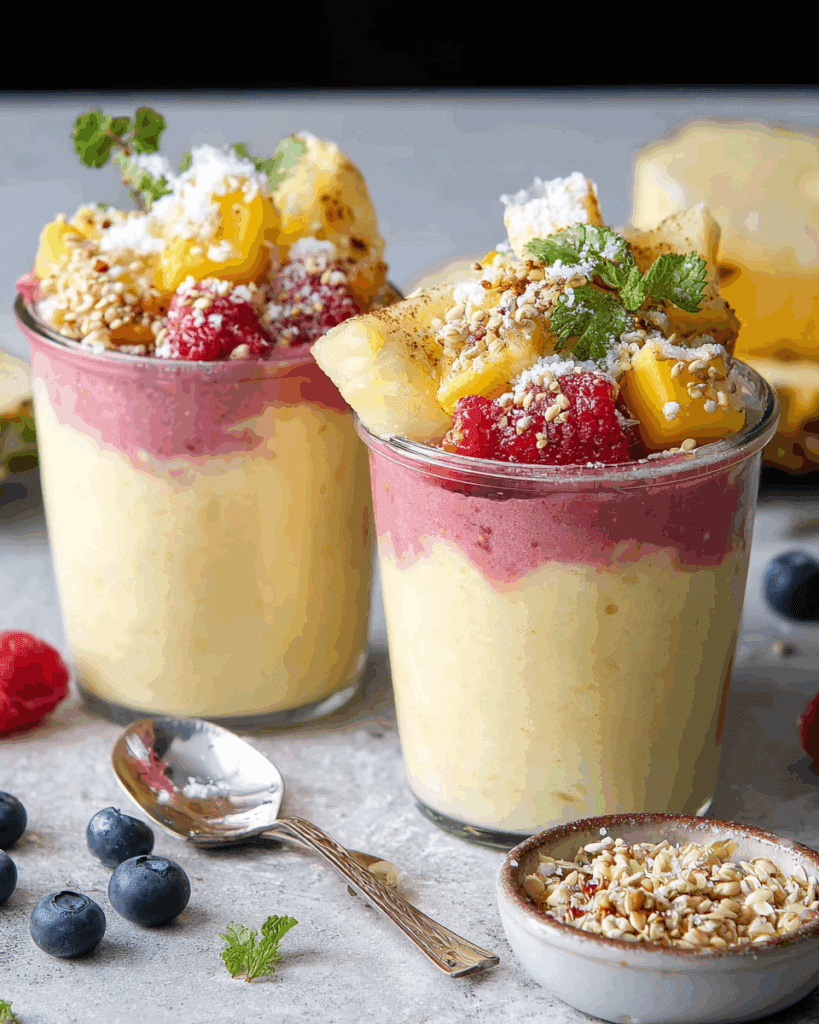
Best Time to Drink an Anti-Inflammatory Pineapple Smoothie
Morning vs Evening Consumption: What’s More Effective?
When it comes to reaping the full benefits of an Anti-Inflammatory Pineapple Smoothie, timing is everything. While you can technically enjoy this vibrant drink anytime, certain hours of the day can amplify its effects on your body.
Morning Wins:
Most health experts agree that the morning is the optimal time to drink an Anti-Inflammatory Pineapple Smoothie, especially on an empty stomach. Why?
- Your digestion is more responsive early in the day.
- Bromelain from pineapple works more effectively when not competing with heavy foods.
- Celery seeds and lemon juice help flush out toxins accumulated overnight.
- Starting your day with antioxidants sets a tone of balance and anti-inflammation from the get-go.
Pairing your smoothie with a light breakfast—like these healthy energy balls—can help sustain energy and keep blood sugar levels steady.
Evening Use:
While less common, drinking an Anti-Inflammatory Pineapple Smoothie in the evening can still be beneficial—especially if you’re using it as a recovery drink after a workout or a way to beat bloating from a heavy meal.
- The natural enzymes in pineapple can aid overnight digestion.
- Pears act as a gentle prebiotic, feeding your good gut bacteria as you sleep.
- Turmeric (if used) helps lower cortisol levels and inflammation that spike during stress.
That said, avoid adding too much lemon juice or tart fruits at night if you have acid reflux. Otherwise, a smaller portion of the Anti-Inflammatory Pineapple Smoothie can help soothe and calm your system.
Pre-Workout or Recovery Smoothie? Timing Hacks That Matter
Another question that comes up often: Should I drink my Anti-Inflammatory Pineapple Smoothie before or after exercise? Great question. Here’s the breakdown:
Before Your Workout:
Drinking the Anti-Inflammatory Pineapple Smoothie 30–45 minutes before exercise gives your body a natural energy boost without heavy carbs or caffeine. The fruit sugars from pineapple and pears deliver fast fuel, while bromelain may help reduce exercise-induced soreness.
For a pre-workout power-up, keep your smoothie light—skip coconut yogurt and opt for oat milk for digestibility.
After Your Workout:
This is where the Anti-Inflammatory Pineapple Smoothie really shines. Post-exercise, your muscles are inflamed, and your body craves antioxidants and hydration.
The bromelain in pineapple helps reduce post-exercise muscle pain. Celery seeds help fight inflammation from physical stress, while lemon juice aids cellular recovery. It’s your all-natural post-workout recovery drink, without protein powder (though you can add one if needed).
Best Time for Different Goals with Anti-Inflammatory Pineapple Smoothie
| Goal | Best Time to Drink |
|---|---|
| Detox & reset | First thing in the morning |
| Post-workout recovery | Within 30 minutes after training |
| Gut health support | Between meals, mid-morning or mid-afternoon |
| Hormonal balance & sleep aid | 1 hour before bedtime (small portion) |
| Bloating relief | After lunch or dinner |
Whether you drink it at dawn, dusk, or after sweating it out, the Anti-Inflammatory Pineapple Smoothie adapts to your lifestyle. It’s a rare combination of flavor, function, and flexibility—no matter your schedule.
Check out this fluffy pineapple recipe to keep the anti-inflammatory benefits going throughout your day.
So if you’re wondering when to sip on this golden tropical miracle, the answer is simple: anytime you want to feel better—but with a few smart tweaks, you can make every glass work even harder for you.
Incorporating Pineapple Smoothies Into Your Daily Routine
Meal Replacement vs Light Snack
One of the best things about the Anti-Inflammatory Pineapple Smoothie is how flexible it is. Whether you’re replacing a full breakfast or just need a mid-day lift, this smoothie works its magic in a variety of ways—without you having to overthink it.
As a Meal Replacement
With the right additions, the Anti-Inflammatory Pineapple Smoothie can go from a refreshing drink to a nutrient-dense meal. Here’s how to upgrade it:
- Add healthy fats: A tablespoon of almond butter, chia seeds, or half an avocado adds satiety.
- Add plant protein: Include hemp seeds, pea protein, or nut-based yogurt to keep you full longer.
- Increase fiber: Toss in some oats or ground flaxseed to slow digestion and support gut health.
This version of the Anti-Inflammatory Pineapple Smoothie is ideal for busy mornings when you need nourishment, hydration, and inflammation support—all in one portable glass.
As a Light Snack
Make the smoothie lighter if you’re searching for something to eat in between meals. Use just 1 cup of frozen pineapple, one pear, and a smaller splash of dairy-free milk. It’ll still deliver anti-inflammatory benefits, without weighing you down.
Pair it with something small like our gluten-free blueberry bites for a light yet energizing snack combo.
Pairing Ideas and Smoothie Bowl Transformations
If you’re the kind of person who likes to eat their smoothie with a spoon, we’ve got you covered. Transforming your Anti-Inflammatory Pineapple Smoothie into a smoothie bowl is a smart way to switch up your routine while keeping inflammation at bay.
Smoothie Bowl Base Recipe:
Make the original Anti-Inflammatory Pineapple Smoothie recipe but reduce the amount of milk to create a thick, scoopable texture.
Toppings That Boost Anti-Inflammatory Effects:
- Shredded coconut – adds texture and healthy fats
- Blueberries or raspberries – double the antioxidants
- Pumpkin seeds or walnuts – rich in omega-3s and zinc
- Coconut yogurt – adds probiotics for gut healing
- Drizzle of raw honey or date syrup – natural sweetness with anti-microbial benefits
Eating your smoothie as a bowl slows down your eating pace, improving digestion and helping you stay more in tune with your hunger signals.
Looking for a creative twist? Try our strawberry frappuccino bowl layered with this smoothie for a colorful blend of cooling, healing ingredients.
Sample Daily Routine with Anti-Inflammatory Pineapple Smoothie
Not sure how to make this smoothie part of your wellness plan? Here’s a simple day plan to incorporate the Anti-Inflammatory Pineapple Smoothie into your life:
| Time of Day | Routine |
|---|---|
| 7:00 AM | Drink Anti-Inflammatory Pineapple Smoothie with chia seeds for breakfast |
| 10:30 AM | Mid-morning walk + a glass of water with lemon |
| 1:00 PM | Lunch: Grilled veggie wrap + light fruit |
| 3:30 PM | Small glass of Anti-Inflammatory Pineapple Smoothie (raspberry version) as snack |
| 6:30 PM | Dinner: Cauliflower crust pizza + side salad |
| 8:00 PM | Optional: Golden turmeric smoothie shot for anti-inflammatory sleep support |
This routine helps maintain low inflammation throughout the day without relying on processed foods or supplements. Your smoothie becomes more than a drink—it becomes a foundation for long-term vitality.
Troubleshooting & Pro Tips
Common Mistakes to Avoid with Anti-Inflammatory Pineapple Smoothies
Even though the Anti-Inflammatory Pineapple Smoothie is easy to make, there are a few sneaky mistakes that can dull its benefits or ruin its taste. Here’s how to avoid them and make sure every sip delivers healing power.
1. Using Canned Pineapple Instead of Frozen Fresh
Canned pineapple is often packed in syrup and stripped of enzymes like bromelain due to heat processing. That means less anti-inflammatory impact. Always go for fresh or flash-frozen pineapple to retain nutrients.
2. Over-blending or Under-blending
Over-blending can create heat in the blender jar, which breaks down enzymes and nutrients. Under-blending leaves stringy fibers that disrupt the smoothie’s texture. Aim for 30–45 seconds at high speed for that smooth, frosty finish.
3. Skipping the Celery Seeds
It’s tempting to leave these out if you’re unfamiliar with the flavor—but celery seeds are key to making this an actual anti-inflammatory powerhouse. Just start small (½ tsp) and adjust as your palate adjusts.
4. Using Sugary Plant Milks
Some store-bought almond or oat milks contain added sugars, gums, or preservatives. These can trigger inflammation—completely countering the purpose of the smoothie. Choose unsweetened, clean-label milk for the best results.
Pro Tip: Try making your own oat milk—just blend rolled oats and water, then strain. Clean, simple, and inflammation-free.
Final Thoughts: The Smoothie That Fights Back
If you’re tired of masking pain, bloating, or fatigue with quick fixes, it’s time to start healing from the inside out. The Anti-Inflammatory Pineapple Smoothie isn’t just a recipe—it’s a wellness habit backed by nature’s finest ingredients and modern nutritional science. Whether you’re sipping it post-workout, layering it for breakfast, or prepping it for the week ahead, every glass becomes a step toward lower inflammation, brighter energy, and deeper nourishment.
And the best part? It’s refreshingly simple.
So, blend up your first Anti-Inflammatory Pineapple Smoothie and experience the difference it can make—one sip at a time.
Don’t miss the Delicious Vanilla Date Smoothie (salted caramel milkshake)!
Frequently Asked Questions About Anti-Inflammatory Pineapple Smoothie
What makes a pineapple smoothie anti-inflammatory?
What turns a regular pineapple smoothie into an Anti-Inflammatory Pineapple Smoothie is the careful choice of ingredients. Pineapple on its own is rich in bromelain—an enzyme that helps break down proteins and reduce swelling. When blended with celery seeds, pears, and lemon juice, the anti-inflammatory effect multiplies.
Each of these ingredients plays a specific role:
Pineapple reduces joint inflammation and supports digestion
Celery seeds help fight oxidative stress and inflammatory markers
Lemon juice boosts detox and immune response
Pears provide fiber and polyphenols that soothe the gut and skin
It’s this synergistic blend that makes the Anti-Inflammatory Pineapple Smoothie a healing drink—not just a tasty one.
Can I drink a pineapple smoothie every day?
Yes, you can safely enjoy an Anti-Inflammatory Pineapple Smoothie daily—especially if you’re using it as part of an anti-inflammatory lifestyle. In fact, drinking this smoothie regularly can help regulate your digestion, improve skin clarity, reduce joint pain, and increase energy levels.
That said, balance is still key. Here’s how to rotate ingredients:
Use different dairy-free milks (almond, oat, coconut)
Add seasonal fruits like mango or berries
Occasionally include turmeric or ginger for variety
Daily smoothies can be a staple if you switch up the flavors and avoid added sugars. Many readers say it’s the most crave-worthy and functional part of their morning routine.
What are the best ingredients to add for inflammation relief?
While the core Anti-Inflammatory Pineapple Smoothie recipe is already loaded with inflammation-fighting elements, you can power it up even more with smart additions.
Here are some anti-inflammatory boosters to mix and match:
Fresh ginger: Eases muscle pain and supports circulation
Turmeric + black pepper: Helps reduce inflammation at the cellular level
Chia seeds or flaxseed: High in omega-3s and fiber
Spinach or kale: Adds iron and antioxidants without changing the taste much
Coconut yogurt: Adds probiotics and healthy fats
Every ingredient should serve a purpose—and in this smoothie, each one supports your body’s natural healing process.
Is it okay to use canned pineapple in smoothies?
Technically, yes—you can use canned pineapple, but it’s not recommended for an Anti-Inflammatory Pineapple Smoothie if you’re looking for real results.
Here’s why:
Canned pineapple is often heat-treated, which destroys the bromelain enzyme responsible for reducing inflammation.
Syrup-packed varieties contain added sugars, which increase inflammation and blood sugar levels.
Even unsweetened versions lack the crisp flavor and full nutrient profile of frozen or fresh pineapple.
If convenience is important, opt for frozen pineapple chunks—they’re flash-frozen to preserve nutrients and easy to store for long-term use.
How long does an anti-inflammatory smoothie last in the fridge?
An Anti-Inflammatory Pineapple Smoothie is best enjoyed fresh, but you can store it in the fridge for up to 24 hours in a sealed, airtight glass jar. Here’s how to store it properly:
Add lemon juice to delay oxidation
Shake well before drinking if the smoothie separates
Keep it cold to preserve the active enzymes and antioxidants
For longer storage, freeze it in cubes or jars and re-blend with dairy-free milk when ready.
Are pineapple smoothies good for gut health?
Absolutely. The Anti-Inflammatory Pineapple Smoothie is an excellent gut-friendly beverage—thanks to its unique combination of fiber, enzymes, and plant-based compounds.
Here’s how it supports digestive wellness:
Bromelain from pineapple helps break down protein and ease bloating
Pears offer soluble fiber that feeds good bacteria in your microbiome
Lemon juice stimulates bile production and detox
Celery seeds may reduce gas and intestinal inflammation
When consumed regularly, this smoothie can lead to better nutrient absorption, fewer digestive issues, and a stronger immune system—all beginning in the gut.

